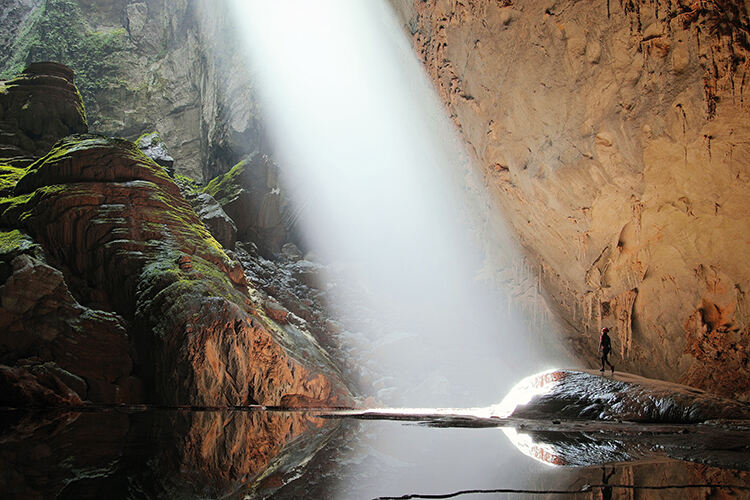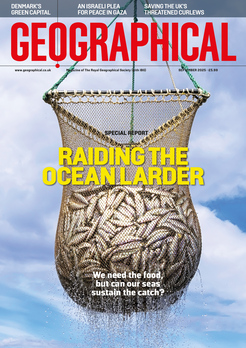
New film A Crack in the Mountain questions the extent to which tourism and conservation can co-exist
British filmmaker Alastair Evans first set foot in Hang Son Doong in March 2017. His plan was to record a 30-minute video for YouTube documenting his journey into the world’s largest limestone cave, located in the heart of Vietnam’s Phong Nha-Ke Bang National Park. Something about the experience, however, would keep him coming back, camera in tow. ‘It was only in 2019,’ he says, ‘when I heard what had happened to the nearby town, and how the discovery of the cave had impacted the local community, that I realised there was a much bigger story to tell.’
Phong Nha-Ke Bang National Park is a remote and largely untouched area of dense tropical forest in central Vietnam. It’s located in Quang Binh, one of the most beautiful, but also poorest, provinces in the country. Beneath its vegetation lies a karst landscape that has been carved out by numerous underground rivers, leaving behind hundreds of caves. In 1990, a local logger named Ho Khanh chanced upon a vast cave opening and, in 2009, he returned with an expert team of British and Vietnamese cavers to survey and document its passages.
Beyond its entrance, the main passage of Son Doong is more than five kilometres long and 200 metres high. It could comfortably accommodate a handful of skyscrapers. ‘It’s this huge, lonely, monolith of a place,’ says Evans. It might not stay that way. In his newly released documentary, A Crack in the Mountain, Evans tells the story of how the cave ‘rebirthed’ the local town of Phong Nha, revealing both the controversial plans to develop the cave for mass tourism and the Vietnamese activists who are fighting to preserve it.
For decades, Phong Nha has been blighted by war, poverty, disease and flooding, and the discovery and subsequent media coverage of Son Doong brought economic growth to the small town. The local tourism industry flourished, providing alternative new jobs to low-paid farming. Currently, just one company – locally owned Oxalis Adventure – is permitted to run tours of Son Doong. Over the past decade or so, it has grown from a company of five to more than 500 employees, 95 per cent of whom are from Phong Nha and the surrounding area, employing 350 porters who largely, according to Oxalis Adventure’s website, used to work as illegal loggers and hunters. ‘Oxalis Adventures has a monopoly on Son Doong cave tours,’ says Evans. ‘There’s obviously been a little bit of controversy about why one company has been given exclusive rights, but I think it’s fairly clear that it’s actually a good thing to have a single company responsible for the protection of Son Doong.’
Vietnam doesn’t have the best history when it comes to sustainable tourism. Cable cars have sprung up across mountains and national parks, ferrying high volumes of tourists into newly accessible areas. Evans says that the cable cars have been tremendously successful, both economically and in terms of their popularity for Vietnamese tourists, so it was no surprise when, in 2014, the Vietnamese government announced its intentions to build one in Son Doong. ‘What they weren’t expecting,’ says Evans, ‘was the level of backlash.’
Activist Huong Le is just one of the people interviewed by Evans who hopes to convince both the Vietnamese and an international public that mass tourism is a big threat to Son Doong and its biodiversity. Evans hopes that his film will raise more awareness among Western tourists, who can voice a preference for more sustainable options. ‘I actually do think that the sustainable approach is by far and away the best way,’ he adds, ‘not just in terms of Son Doong, but for tourism as a whole.’ Not everyone agrees.
In an email, biologist Anette Becher, who featured in a 2011 National Geographic documentary about Son Doong, declines to talk about the fauna she found there – in part, she says, because her knowledge of the cave is no longer current; her last visit was in 2010. Although she acknowledges the significant benefits that tourism has brought to a limited number of locals, she fears that this has come at a cost to the wildlife. ‘The area appears to have changed so much that I am not even sure I want to visit again,’ she writes.
Evans doesn’t consider himself to be an environmentalist. ‘I care deeply about sustainability and environmental protection, but I’m not a hardcore activist.’ Similarly, A Crack in the Mountain isn’t advocating for a single solution, instead focusing on the tension between the competing needs for economic development and environmental protection. ‘It would have been very easy to make a film that says Son Doong should be protected at all costs, but that doesn’t represent the discussions that everyone was having on the ground,’ says Evans. ‘It would have been a betrayal not to acknowledge the different perspectives.’
For screening details and trailer, go to www.acrackinthemountain.com/watch




